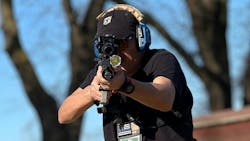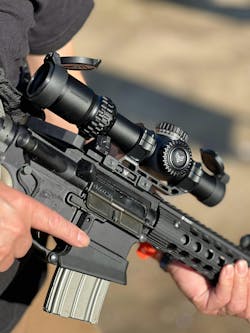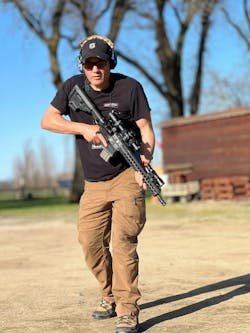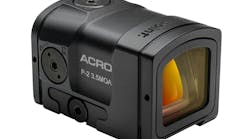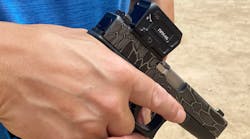Law enforcement officers probably make twice the number of critical decisions in some shifts that ordinary mortals make in their entire lifetime. Additionally, decisions that could otherwise be considered mundane, like “Where to park?” and “In which pocket should I keep this?,” can have real advantages or consequences When it comes to the optic mounted on the carbine, the most versatile tool is the best tool.
I tested the Swampfox WARHORSE, a 1x-6x low power variable optic (LVPO) scope designed for rapid target transition. I found the Dragoon reticle, which consists of a horseshoe that sits on top of an inner tree, allowing for quick acquisition, and decision-making. The smooth power selection gave it the ability to address close threats, moving targets, and take precision shots using the same tool and platform.
During the time when Law Enforcement Agencies began to use mounted lights, optics, and accessories on AR-15 platforms, scope makers began testing the waters. Most of us wanted a magnification option but wanted to keep the advantage of low power, so non-occluded sighting could still be used up close.
Originally, the standard was a 1-inch tube, with 1-4 power. None of this was written in stone, but most of us wanted 1 power with an illuminated reticle. Optics designers began gravitating towards 30mm tubes, only slightly larger than 1 inch. I was under the impression that light transmission was the biggest factor, but, quite frankly, quality optics and great coatings are a greater factor than the aperture of the tube.
Perhaps the thicker tubes made the package stronger. Crushproof is good, isn’t it? Actually, many of the scope products are stronger than they were twenty years ago, but not every one makes fatter scopes with thicker walls. Really, the greatest advantage is the extra room for windage and elevation travel, and the ability to add bigger and stronger turrets.
You should know that the downside of fatter scopes is the availability of mounts. Many manufacturers offer their own mount options. I got the Freedom mount for the Warhorse, which is a Picatinny rail mount that puts the front ring forward of the rail limit on a standard AR-15 rail, allowing for plenty of eye relief, if necessary. The Freedom Mount has plenty of clamping power, with good clamping distribution.
What’s the other down side of fat scopes? There’s about a 3-4 oz difference between this scope and 30mm scopes with similar qualities. Adding a few more ounces on a lightweight carbine is a lot.
The torque of any scope mount is critical. Squeeze the tube too little, and it does not hold adjustment. Squeeze it too much and it affects gimbal movement. Gunsmith Richard Maccia used the Fix It Sticks All-in-One Torque Driver for precise mounting on the Freedom Mount.
The Warhorse does have larger turrets, compared to any other scope in my inventory. They can adjust 100 MOA or (or 29.08 MILs, if the user ops for a Warhorse graduated in milliradians), and 150 MOA elevation (43.53 MILs).
To tell you the truth, it is amazing to have all of this adjustment, but, unless the user shoots all day in full value winds, or engages from street level to high rise all day, no one will use the full adjustment. The advantage of a fatter tube lies in accuracy and repeatability.
Modern scopes use an erector tube within the main tube, or a similar arrangement, to accomplish alignment, or “sighting in”. The erector tube is adjusted by a gimbal device, which screws it back and forth and up and down. It is kept in alignment by a spring, which presses against the tube, holding it securely against the gimbal device. A larger main tube allows for larger fittings in the gimbal device, and better springs to press against the scope body to hold the erector tube in place. Larger tubes mean the windage adjustments are more likely 100% horizontal and the elevation 100% vertical, just because of the larger margin for error. It also means that the components will maintain their integrity over time, compared to scopes manufactured 20-30 years ago.
Is there a point where there is a diminishing return? That is, if 34 works, is 50 better? I really don’t know, but 34mm is a good balance of weight and handling.
How do I test a scope for repeatability? First, I sight it in on the platform I’m using. Then, I run the adjustments all the way from one side to the other, several times. I set it back to the sighted in setting and shoot again. That’s where I start. After that, I use a laser sighting device. The reticle settings are a bit more complicated. That is, I compare the scope power setting with the size of the reticle increments against the actual distance. After that, I shoot.
Every scope manufacturer uses precision clicks for the windage and elevation settings. Swampfox does it with well-machined materials, not flimsy plastic stuff. The turret settings are either .25 MIL or 1 MOA, depending on which model the user purchases.
The Warhorse was consistent throughout the testing, and cleanly came back to its original settings. One thing I noticed was the fact that the power ring ran smoothly, but had enough tension to maintain a consistent power setting under recoil. It was as if I was rotating a massive water wheel mounted on precision bearings. The scope came with a lever that clamps over this ring, and I recommend that users opt for the lever-not for smoothness, because they nailed this part-but for speed in adjustments.
The Warhorse is a first focal plane optic, meaning the image of the etched reticle changes in size, relative to the magnification. As the user raises the magnification, the size of the reticle increases at the same time. The opposite is the second focal plane reticle, where the size of the reticle is constant. There are advantages and disadvantages of both, but, for our purposes, the benefits are big. First, because the reticle grows when the image of the target grows, the scope can be used for ranging.
Ranging is not quite a requisite skill in precision shooting for shooters whose laser rangefinders can calculate to the inch these days. That’s what we used to use ranging for, back in the day. If a 6’ man was 10 MILs in my scope, he was 183 meters away. If 7.5 MILs, he was 250. Are you going to do ranging with a scope mounted on an AR-15? Probably not. After all, the bullet drop of most 5.56 rounds runs from 2-4” out to 200 yards. Range calculations for these ranges, using these cartridges, for these purposes, can be done on the fly.
What would you use the Dragoon Reticle for (and why does Lindsey recommend it)? Precise holdovers can be quickly done with this reticle. A grown man is approximately 20” from one side of the chest to the other. At 100 yards, the person will roughly fit inside the 26 MIL horseshoe. If the chest fits from the second small dot to the “x” on the tree, it’s 200 yards. From there, one can quickly calculate a precision shot using the tree, and even dope wind, without even running the turrets. With this reticle, I could crank out a working range card in minutes.
I didn’t work this scope in the dark, but I tried low light to get an idea of the coatings. This scope has an exit pupil of 7.7mm, when set wide open. This means it has more potential brightness than I can actually process, considering age, etc.
The important aspect is the lack of confusing reflections inside the tube. The glass is clean. The etched reticle is useful and uncluttered. This reticle is of the same quality as scopes costing three times the price of the Warhorse. The outside lenses are hydrophobic and anti-reflective.
How’s the price? MSRP is $639. Generally, a scope that has these features run about twice this price. They didn’t skimp on glass, nor did they skimp on finish. In fact, it appears they didn’t skimp on anything. I’m running the Warhorse on my working gun, and it is a fully capable patrol tool.
About the Author
Lindsey Bertomen is a retired police officer and retired military small arms trainer. He teaches criminal justice at Hartnell College in Salinas, California, where serves as a POST administrator and firearms instructor. He also teaches civilian firearms classes, enjoys fly fishing, martial arts, and mountain biking. His articles have appeared in print and online for over two decades.
